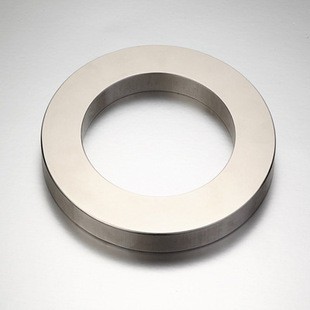How to bond a ring magnet to a surface?
 Jul 25, 2025|
Jul 25, 2025| Bonding a ring magnet to a surface might seem like a piece of cake at first glance, but trust me, it's got its fair share of challenges. As a ring magnet supplier, I've seen it all - from DIY enthusiasts struggling to get the perfect bond for their home projects to large - scale manufacturers looking for reliable bonding solutions. In this blog, I'll walk you through the whole process, step - by - step.
Understanding Your Ring Magnets
First things first, you need to know what kind of ring magnets you're working with. We offer a variety of ring magnets, like the Magnet Source Neodymium Magnet Ring. Neodymium magnets are super strong and are often used in high - performance applications. They're known for their excellent magnetic properties, but they can be a bit brittle.
Then there's the Diametrically Magnetized Ring Magnet. These magnets have a unique magnetization pattern, which makes them suitable for specific applications such as sensors and motors. And let's not forget the Super Magnetic Ring, which lives up to its name with its powerful magnetic force.
The type of magnet you choose will play a big role in the bonding process. For example, neodymium magnets require a bonding agent that can withstand their strong magnetic forces and won't break down under stress.
Surface Preparation
Before you even think about applying any adhesive, you've got to prep the surface. This is a crucial step that's often overlooked, but it can make or break your bond.
Cleaning the Surface
The surface where you'll be attaching the ring magnet needs to be clean and free of any dirt, grease, or debris. You can use a mild detergent and water to clean it, then dry it thoroughly with a clean cloth. For stubborn grease or oil, you might need to use a solvent like isopropyl alcohol. Just make sure to let the surface dry completely before moving on.
Roughening the Surface
In some cases, it can be beneficial to roughen the surface slightly. This gives the adhesive something to grip onto, creating a stronger bond. You can use fine - grit sandpaper to gently sand the surface. Be careful not to overdo it, though, as you don't want to damage the surface or create unevenness that could affect the magnet's performance.
Cleaning the Magnet
Don't forget to clean the magnet itself! Use a soft cloth and a mild cleaning solution to remove any dust or fingerprints. Just like with the surface, make sure the magnet is completely dry before bonding.
Choosing the Right Adhesive
There are a ton of adhesives out there, but not all of them are suitable for bonding ring magnets. Here are some factors to consider when choosing an adhesive:
Strength
You need an adhesive that can hold up to the magnetic forces of the ring magnet. Epoxy adhesives are a popular choice because they offer high strength and durability. They can withstand a lot of stress and are resistant to heat and chemicals.
Cure Time
Some adhesives cure quickly, while others take longer. If you're in a hurry, you might want to choose a fast - curing adhesive. However, keep in mind that fast - curing adhesives might not have the same strength as slower - curing ones.


Compatibility
Make sure the adhesive is compatible with both the magnet and the surface material. For example, if you're bonding a neodymium magnet to a plastic surface, you need an adhesive that will bond well with both materials.
Applying the Adhesive
Once you've chosen the right adhesive, it's time to apply it. Here's how to do it:
Follow the Instructions
Every adhesive comes with its own set of instructions, so make sure to read them carefully. Some adhesives need to be mixed before use, while others come ready - to - apply.
Apply the Adhesive
Use a small brush or a syringe to apply a thin, even layer of adhesive to either the magnet or the surface. Be careful not to apply too much adhesive, as this can cause it to squeeze out and create a mess.
Align the Magnet
Carefully place the ring magnet on the surface, making sure it's in the right position. You might want to use a fixture or a template to help you align the magnet correctly. Apply gentle pressure to ensure good contact between the magnet and the surface.
Let the Adhesive Cure
Once the magnet is in place, let the adhesive cure according to the manufacturer's instructions. This might take anywhere from a few minutes to several hours, depending on the type of adhesive you're using. Avoid disturbing the magnet during the curing process.
Testing the Bond
After the adhesive has cured, it's a good idea to test the bond. Gently try to move the magnet to see if it's firmly attached. If the magnet moves easily, the bond might not be strong enough, and you might need to start over.
Troubleshooting
Sometimes, things don't go as planned. Here are some common problems and how to fix them:
Weak Bond
If the bond is weak, it could be because the surface wasn't properly prepared or the adhesive wasn't applied correctly. Try cleaning the surface again and applying a new layer of adhesive.
Adhesive Squeeze - Out
If you have adhesive squeezing out around the edges of the magnet, you can use a sharp blade or a scraper to remove it while the adhesive is still wet.
Magnet Misalignment
If the magnet is misaligned, you might need to remove it and start over. Be careful when removing the magnet, as you don't want to damage the surface or the magnet itself.
Conclusion
Bonding a ring magnet to a surface isn't always easy, but if you follow these steps, you should be able to get a strong, reliable bond. Remember, the key is to choose the right magnet, prepare the surface properly, select the right adhesive, and apply it correctly.
If you're in the market for high - quality ring magnets or need more advice on bonding them, don't hesitate to reach out. We're here to help you with all your magnet needs and can offer customized solutions based on your specific requirements. Whether you're a hobbyist or a large - scale manufacturer, we've got the products and expertise to meet your needs. Contact us today to start a conversation about your next project!
References
- "Magnet Handbook" by Magnetics International
- "Adhesive Technology Handbook" by Society of Adhesive and Sealant Technologists

